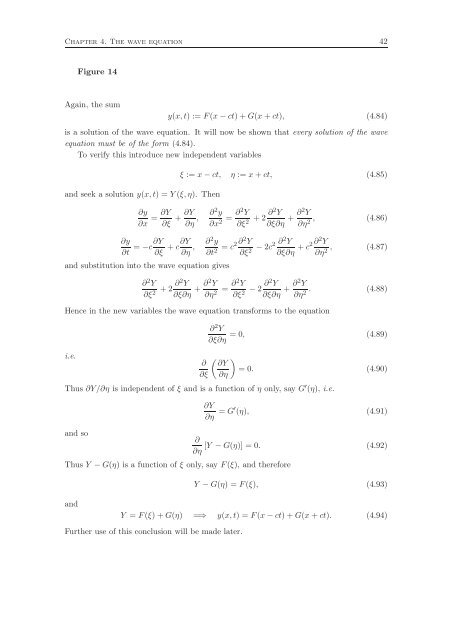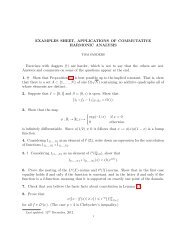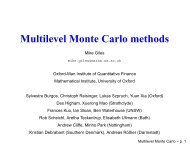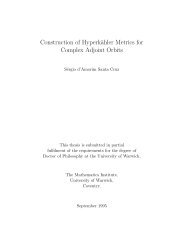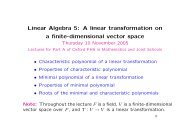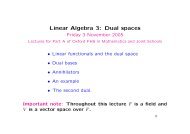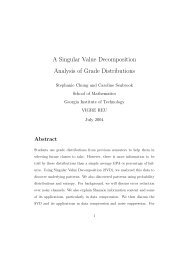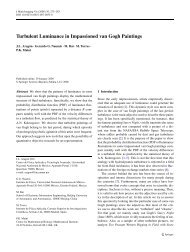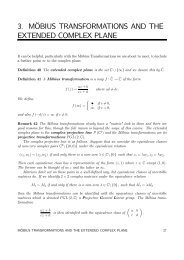Fourier Series and Partial Differential Equations Lecture Notes
Fourier Series and Partial Differential Equations Lecture Notes
Fourier Series and Partial Differential Equations Lecture Notes
You also want an ePaper? Increase the reach of your titles
YUMPU automatically turns print PDFs into web optimized ePapers that Google loves.
Chapter 4. The wave equation 42<br />
Figure 14<br />
Again, the sum<br />
y(x,t) := F(x−ct)+G(x+ct), (4.84)<br />
is a solution of the wave equation. It will now be shown that every solution of the wave<br />
equation must be of the form (4.84).<br />
To verify this introduce new independent variables<br />
<strong>and</strong> seek a solution y(x,t) = Y(ξ,η). Then<br />
∂y<br />
∂t<br />
∂y ∂Y<br />
=<br />
∂x ∂ξ<br />
ξ := x−ct, η := x+ct, (4.85)<br />
+ ∂Y<br />
∂η ,<br />
= −c∂Y<br />
∂ξ +c∂Y<br />
∂η ,<br />
<strong>and</strong> substitution into the wave equation gives<br />
∂ 2 y<br />
∂x 2 = ∂2 Y<br />
∂ξ 2 +2 ∂2 Y<br />
∂2y ∂t2 = c2∂2 Y<br />
∂ξ2 −2c2 ∂2Y ∂ 2 Y<br />
∂ξ 2 +2 ∂2 Y<br />
∂ξ∂η + ∂2 Y<br />
∂η 2 = ∂2 Y<br />
∂ξ 2 −2 ∂2 Y<br />
∂ξ∂η + ∂2Y , (4.86)<br />
∂η2 ∂ξ∂η +c2∂2 Y<br />
, (4.87)<br />
∂η2 ∂ξ∂η + ∂2Y . (4.88)<br />
∂η2 Hence in the new variables the wave equation transforms to the equation<br />
i.e.<br />
∂ 2 Y<br />
∂ξ∂η<br />
= 0, (4.89)<br />
<br />
∂ ∂Y<br />
= 0. (4.90)<br />
∂ξ ∂η<br />
Thus ∂Y/∂η is independent of ξ <strong>and</strong> is a function of η only, say G ′ (η), i.e.<br />
<strong>and</strong> so<br />
∂Y<br />
∂η = G′ (η), (4.91)<br />
∂<br />
[Y −G(η)] = 0. (4.92)<br />
∂η<br />
Thus Y −G(η) is a function of ξ only, say F(ξ), <strong>and</strong> therefore<br />
<strong>and</strong><br />
Y −G(η) = F(ξ), (4.93)<br />
Y = F(ξ)+G(η) =⇒ y(x,t) = F(x−ct)+G(x+ct). (4.94)<br />
Further use of this conclusion will be made later.


